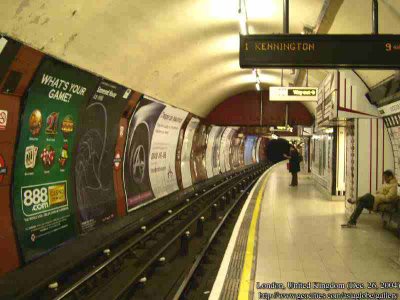History of the Tube
1843 - Opening of the Thames Tunnel, constructed by Sir Marc Brunel and his son Isambard.
1863 - The Metropolitan Railway opened the world's first underground railway on 10 January between Paddington (Bishop's Road) and Farringdon Street.
1900 - Prince of Wales opens the Central London Railway from Shepherd's Bush to Bank (the "Twopenny Tube", now part of the Central Line).
1906 - Baker Street & Waterloo Railway, now part of the Bakerloo Line, opened from Baker Street to Kennington Road, now Lambeth North. Great Northern, Piccadilly & Brompton Railway, now part of the Piccadilly Line, opened between Hammersmith and Finsbury Park.
1907- Charing Cross, Euston & Hampstead Railway, now part of the Northern Line, opened from Charing Cross to Golders Green and Highgate, now Archway. All three of these 1906 & 07 tubes were American-financed.

This is a photo of Leicester Square station of the Northern line
(the southbound platform, the next train terminating at Kennington is in 9 minutes)
1913 - First appearance of the famous circle and horizontal bar symbol (the roundel).

1929 - Last manually operated doors on tube trains replaced by air-operated doors.
1933 - First Underground map in diagrammatic form, devised by Harry Beck.
1961 - End of steam and electric locomotive haulage of London Transport passenger trains.
1969 - The Queen opens the Victoria Line.
1975 - Fatal accident on the Northern line at Moorgate in which forty-three people were killed. New safety measures introduced.
1979 - The Prince of Wales opens the Jubilee Line.
1984 - The Hammersmith & City and the Circle lines converted to one-person operation.
1987 - Tragic fire at King's Cross killed 31 people.
1989 - New safety and fire regulations introduced following the Fennell Report into the King's Cross fire.
1993 - £70 million Angel Station reconstruction completed. Work started on the extended Jubilee Line from Green Park to Stratford.
1999 - Opening of extended Jubilee line and through services from Stanmore to Stratford.
2000 - All 106 new trains in service on the Northern line.
Average train speed
20.5mph - including station stops
In central London, trains cannot reach speeds of more than 30-40 mph because of the short distance between stations.
On the Victoria line, where stations are further apart, trains reach speeds of up to 50 mph.
On the Metropolitan line, trains can reach over 60 mph.
Facts and Figures

Number of miles travelled by each Tube train each year: 73,500
Total number of passengers carried on the Tube each year: 976 million
Length of network: 408km/253 miles
Proportion of the network which is in tunnels: 45 per cent
Longest continuous tunnel: East Finchley to Morden (via Bank) - 17.25 miles
Longest escalator: Angel - 197ft, with a vertical rise of 90ft (it is weird looking up!!)
Cars in LU's fleet: 4070
Total number of stations served: 275
Total number of stations owned and managed: 255
LU staff: 12,560
Stations with the most platforms: Moorgate and Baker Street have 10 platforms each
Busiest stations: During the three-hour morning peak, London's busiest Tube station is Waterloo, with 46,000 people entering.
The busiest station in terms of passengers each year is Kings Cross St Pancras with 77.5 million passengers a year.
Passengers enter the Tube system at a rate of 150,000 people an hour
The London Underground has been known as The Tube since 1890, when the first deep-level electric railway line was opened
The Underground name first appeared on stations in 1908
LU's world-famous logo, the roundel - a red circle crossed by a horizontal blue bar - was designed by calligrapher Edward Johnston and first appeared in 1913



0 Comments:
Post a Comment
<< Home